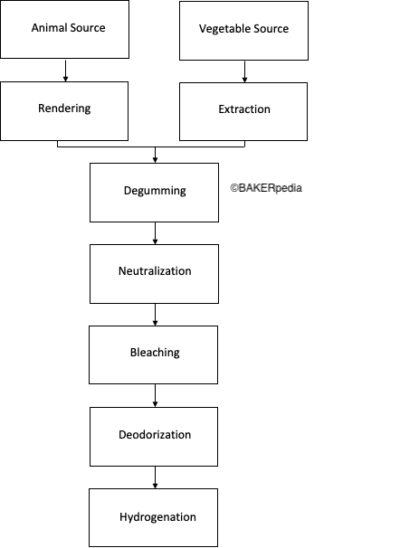Origin
Fats can be derived from both animal and plant sources. Lard extraction from pig fat via boiling in water and skimming off is a very ancient practice. Butter is traditionally prepared from milk cream churning. Concerns about high cholesterol content of animal-sourced fats created the need for solidifying vegetable oils using hydrogenation.3
Function4
In bakery products, fat serves many functions:
- Flavor enhancer: this is most pronounced with animal-based fats, which impart richness and unique flavor notes.
- Texture: mainly reduced toughness and enhanced tenderness.
- Moistness and mouthfeel: via coating the tongue and eliminating food surface grittiness.
- Leavening: via incorporating air during creaming and baking.
- Delayed staling: a result of fat’s interference with starch gelatinization.
These functions are typically dependent on fats’ inherent characteristics such as:
- Plasticity: an important attribute for shortenings.
- Ratio of solid:liquid content: the higher the solid content the higher the fat melting point.
- Oxidative stability: unsaturated fats are readily oxidized and hydrogenation has been used to enhance their oxidative stability. Generation of trans fat, however, is a major drawback for hydrogenation
Types/Variations4
- Lard: contains 100% fat and is obtained from hog fat
- Shortening: is made from hydrogenated soybean oil or other vegetable sources. Consist of 100% fat.
- Oils: are liquid fats obtained from seeds such as soybean, corn or cottonseed. They contain 100% fat.
- Butter: contains 80% fat and 20% water and is made from churning cream. It is available commercially in the salted or unsalted varieties.
- Clarified Butter: is butter that has been heated to remove the milk solids sediments to form a clear color.
- Margarine: is made from hydrogenated soybean oil or other vegetable sources. Consists of 80% vegetable fat and 20% water.
- Cocoa Butter: is extracted from cocoa beans.
Nutrition
Lipids are energy dense nutrients (9 kcal/g). Most polyunsaturated fatty acids including omega-3 and similar structures are essential for many biological functions. However, concerns remain with animal-based fats due to their high cholesterol content. Also hydrogenated oils can be a source of harmful trans-fatty acids.2
Commercial production2
The following diagram describes the process of vegetable oil extraction and making of shortening:

Application
Categorization of fats is based on their:2
- Physical form: solids and semisolids (lard, butter, shortening) or liquids (oils).
- Chemical composition: type and length of fatty acid chains, degree of saturation.
- Solubility: fats are insoluble in water but soluble in organic solvents.
Fats such as butter, shortenings or hydrogenated fats are typically used in bakery goods including cakes, puff pastry, breads, cookies, scones, pie crusts.1,4
In puff pastry such as croissants, butter is responsible for their desirable flaky texture. As the butter laminated dough enters the hot oven, the water component in the butter evaporates and the generated steam causes the dough to rise.
In cookies, fats are typically creamed with sugar, thus providing for their chewy texture. In cakes, fats can either be creamed with sugar to act as a leavening agent or are added as such to promote moistness and soft texture. In breads, fats act as dough lubricants which help with loaf rise and crumb softening.
FDA regulations
Fats are considered GRAS ingredients. However, since 2015 the consumption of trans fats such as partially hydrogenated oils (PHO’s) are no longer considered safe by the FDA. The consumption of saturated fats has a recommended consumption limit of 10 % calories per day.5
References
- Kamel, B. S., and C. E. Stauffer. Advances In Baking Technology. 1st ed., Springer, 1993, pp. 336-250.
- Damodaran, Srinivasan et al. Fennema’s Food Chemistry. 4th ed., CRC Press/Taylor & Francis, 2007, pp. 157-186.
- Food and Drug Administration. “Trans Fat”. Food Additives & Petitions, 18 May 2018. https://www.fda.gov/food/food-additives-petitions/trans-fat .Accessed 1 Apr 2020.
- Figoni, P. How Baking Works: Exploring The Fundamentals Of Baking Science. 2nd ed., John Wiley & Sons, Inc., 2008, pp. 209-223.
- U.S. Department of Health and Human Services and U.S. Department of Agriculture. 2015 – 2020 Dietary Guidelines for Americans. 8th Edition. December 2015. Available at https://health.gov/our-work/food-and-nutrition/2015-2020-dietary-guidelines/. Accessed 1 Apr 2020.

